I realize this isn’t exactly metal detecting related, but I wanted to share it with you all the same. I was an executive on the Historical Lighting Society of Canada for many years and it still bothers me when I find an old oil lamp that can still be useful today. At one point I owned 300+ oil lamps, mainly early US-made J.F. Iden figurals and Sandwich Glass whale oil lamps… I now only have two lamps left in my collection.

When I found this solid brass, electrified c1895 Edward Miller & Co. lamp listed on Kijiji for $25cdn last Monday I just had to grab it! It still had the original white milk-glass shade and was in great condition for being almost 125 years old! The original owner, who I bought it from was in her early 70s. She proceeded to tell me, “that her husband found it in his grandmother's attic in early 1970s. The family originally moved from Lockport, NY to St Catherines, ON in the 1930s.” This lamp was likely electrified sometime in the 1950s by the original owners who cherished this lamp and wanted to continue to use it.
I started by completely disassembling the lamp. I then bought a new electrical socket and cord, as it still had the old porcelain type and a 1950’s style electrical cord/plug. I washed all the parts in soap and water, I then used Brasso to clean the brass followed by Flitz Metal Cleaner and a lot of elbow grease. I think it looks amazing when lit now that it’s all polished up and will hopefully be functional for another 125 years!
 The first few pics of the lamp were taken by the seller when it was posted online.
The first few pics of the lamp were taken by the seller when it was posted online."Edward Miller & Co. (1844-1924) was formed in Meriden, Connecticut and is primarily known as a historical manufacturer of lamps. The company also made brass kettles and oil heaters. In 1866, the corporation was formed with capital of $200,000us. Its earlier beginning included being started by Horatio Howard. The following year the business was sold to Edward Miller. In the 1870s, the company grew and new stores were opened at 56-58 Park Place and 51-53 Barclay Street in New York, NY. Stores were also opened in Boston, at 38 Pearl Street, and Chicago. Also, salesrooms were opened in Philadelphia and San Francisco. In 1893, Edward Miller & Co. employed about 700 people. By 1916, the company had salesrooms in Boston (201 Congress Street), New York (68 and 70 Park Place), and Philadelphia (1727 Chestnut Street). On February 24, 1924, Edward Miller & Co assets, "property, good will and business as a going concern", were formally transferred to "The Miller Company" (1924–present).
During its years of operation, the company exhibited in national and international expositions. These include the 1876 Centennial Exposition, for which the company received an award. Also, Edward Miller & Co. exhibited in the 1879-80 Sydney International Exhibition and 1881 Melbourne International Exhibition in Australia; the 1889 Meriden Opera House exhibition; the 1899 Greater America Exposition in Omaha, Nebraska; and the 1901 Pan-American Exposition in Buffalo, New York.[4] Museums holding the company's design in their collections include the Connecticut Historical Society in Hartford; the Corning Museum of Glass in Corning, New York; The Henry Ford in Dearborn, Michigan, as well as museums in Australia and New Zealand. The Miller Company manufactured electric lamps through the 20th century. The Miller Company was sold to Diehl in 2000."
Thanks very much for looking,
Dave
Amazon Forum Fav 👍
Attachments
-
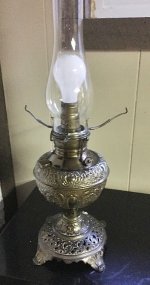 lamp003.JPG59.7 KB · Views: 83
lamp003.JPG59.7 KB · Views: 83 -
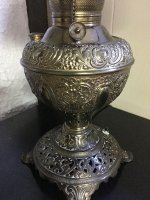 lamp002.JPG125.5 KB · Views: 83
lamp002.JPG125.5 KB · Views: 83 -
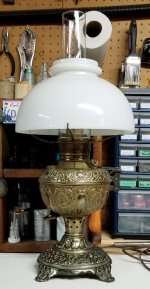 20191210_153022.jpg419.6 KB · Views: 77
20191210_153022.jpg419.6 KB · Views: 77 -
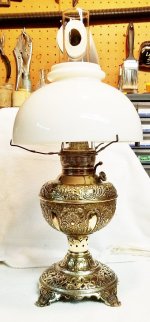 20191215_171154.jpg213.1 KB · Views: 82
20191215_171154.jpg213.1 KB · Views: 82 -
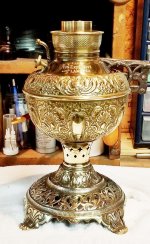 20191215_111825.jpg365.2 KB · Views: 84
20191215_111825.jpg365.2 KB · Views: 84 -
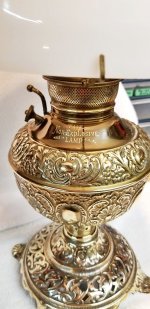 20191215_163602.jpg235.9 KB · Views: 83
20191215_163602.jpg235.9 KB · Views: 83 -
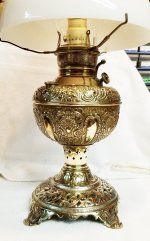 20191215_170929.jpg255.5 KB · Views: 85
20191215_170929.jpg255.5 KB · Views: 85 -
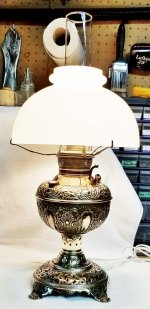 20191215_170338.jpg224 KB · Views: 83
20191215_170338.jpg224 KB · Views: 83
Last edited:






